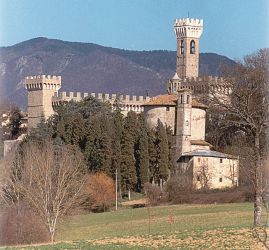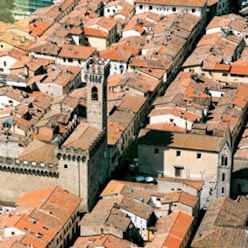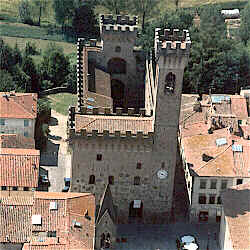 |
 |
 |
|
Castello Fortezza of Scarperia (Palazzo dei Vicari) |
||
Scarperia in Tuscany, Italy |
||
The town of Scarperia in the Mugello region of Tuscany near Florence |
||
|
Scarperia |
 |
 |
 |
|
Castello Fortezza of Scarperia (Palazzo dei Vicari) |
||
|
Scarperia is one of the most interesting historic centres in the Mugello zone, the Apennine passes of which connect it to Bologna and the region of Emilia-Romagna. There has also been a revival of the art of hand-made knives, once a major industry here.
History of Scarperia• 1299: in order to
reorganise and better control its
territory, the Council of One Hundred of the Municipality of Florence established two new fortified settlements, one on each side of the Giogo Apennine pass, an important communication route between Florence and the region of
Emilia-Romagna.
|

Another Scarperia hand-made knife - a Zuava with a functional sundial
|
Palazzo dei Vicari at ScarperiaFrom the 15
C onwards, Scarperia, in the "New Land" of the Florentines, was
a vicariate and therefore housed the offices of the Florentine Civil Service
for this large part of the Mugello. The Medici family, whose policy was to maintain progressive control of the Republican Magistrature, was particularly interested in holding the office and appointing a member of a loyal family as Vicar. The members of these families took turns running the office throughout the 15
C. The heart of the fortified settlement is the Vicars Palace. Its
residential section on the side facing the square, stark and turreted,
presents a 14 C plan, while the fortified section lies behind. Other sights of ScarperiaThe Palace of the
Vicars overlooks the main piazza and two noteworthy religious
structures. The first is the Propositura, founded by Friar Napoleone dei
Galluzzi in 1326 and dedicated to Saints Jacob and Philip. The
church, enlarged in 1870 and redesigned by the architect Mario Falcini,
has a marble roundel by Benedetto da Maiano, a tabernacle by Mino da
Fiesole and a crucifix by Sansovino, as well as numerous paintings. Scarperia FestivalsInfiorata on the last Sunday of May - the streets of the Scarperia are decorated with flowers petals during the night before to illustrate a theme that changes every year. Smaller but just as pleasing as the similar event at Spello on Corpus Domini. Dicotto and Renaissance festival - first Sunday of September and 8 September. This events celebrates the founding of Scarperia, with the main parades, flag throwing and games taking place on 8 September. A large part of the population participates in Renaissance costume. |
Mugello Tuscany © ammonet IntoTech 2007 - 2020